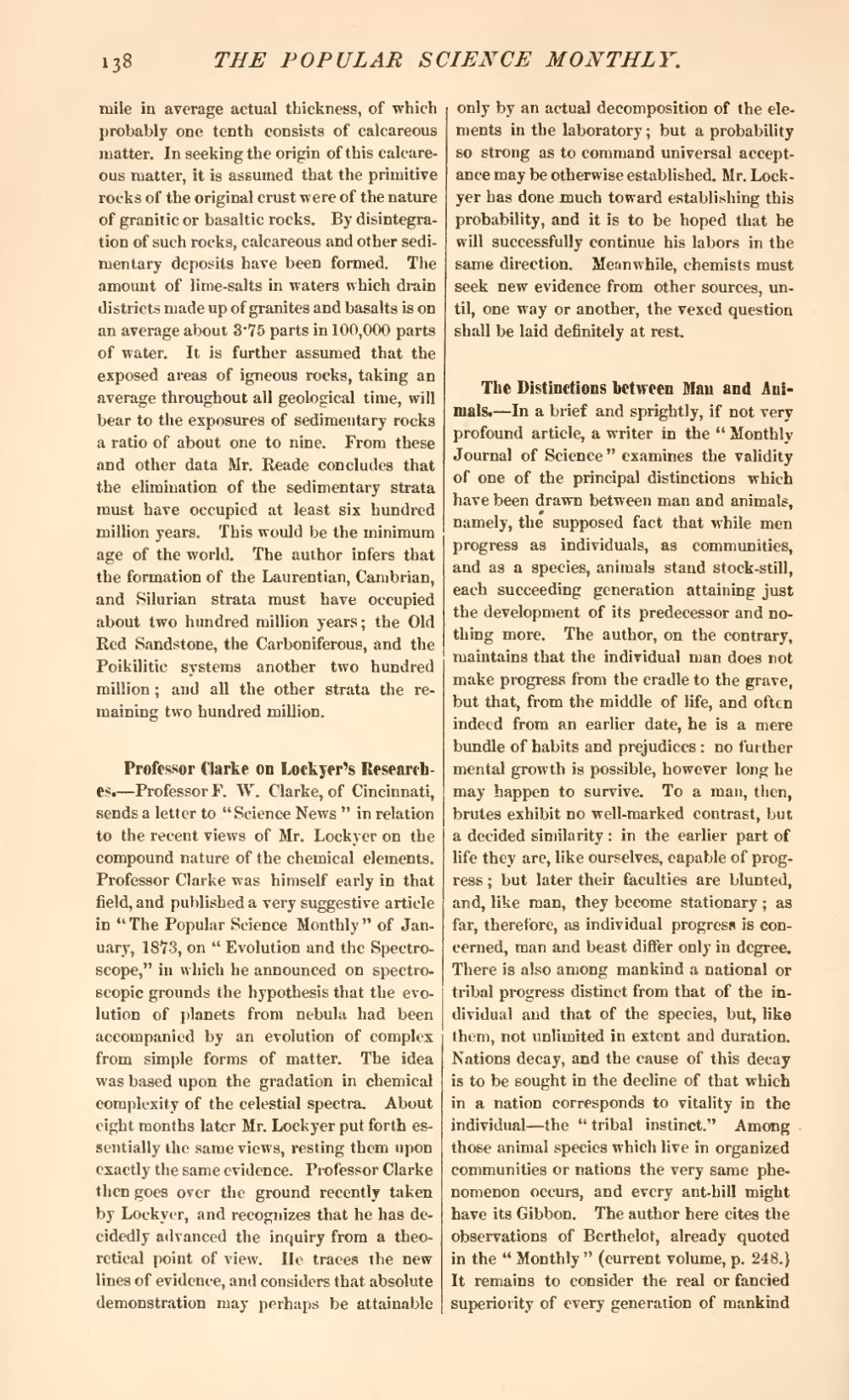mile in average actual thickness, of which probably one tenth consists of calcareous matter. In seeking the origin of this calcareous matter, it is assumed that the primitive rocks of the original crust were of the nature of granitic or basaltic rocks. By disintegration of such rocks, calcareous and other sedimentary deposits have been formed. The amount of lime-salts in waters which drain districts made up of granites and basalts is on an average about 3·75 parts in 100,000 parts of water. It is further assumed that the exposed areas of igneous rocks, taking an average throughout all geological time, will bear to the exposures of sedimentary rocks a ratio of about one to nine. From these and other data Mr. Reade concludes that the elimination of the sedimentary strata must have occupied at least six hundred million years. This would be the minimum age of the world. The author infers that the formation of the Laurentian, Cambrian, and Silurian strata must have occupied about two hundred million years; the Old Red Sandstone, the Carboniferous, and the Poikilitic systems another two hundred million; and all the other strata the remaining two hundred million.
Professor Clarke on Lockyer's Researches.—Professor F. W. Clarke, of Cincinnati, sends a letter to "Science News" in relation to the recent views of Mr. Lockyer on the compound nature of the chemical elements. Professor Clarke was himself early in that field, and published a very suggestive article in "The Popular Science Monthly" of January, 1873, on "Evolution and the Spectroscope," in which he announced on spectroscopic grounds the hypothesis that the evolution of planets from nebula had been accompanied by an evolution of complex from simple forms of matter. The idea was based upon the gradation in chemical complexity of the celestial spectra. About eight months later Mr. Lockyer put forth essentially the same views, resting them upon exactly the same evidence. Professor Clarke then goes over the ground recently taken by Lockyer, and recognizes that he has decidedly advanced the inquiry from a theoretical point of view. He traces the new lines of evidence, and considers that absolute demonstration may perhaps be attainable only by an actual decomposition of the elements in the laboratory; but a probability so strong as to command universal acceptance may be otherwise established. Mr. Lockyer has done much toward establishing this probability, and it is to be hoped that he will successfully continue his labors in the same direction. Meanwhile, chemists must seek new evidence from other sources, until, one way or another, the vexed question shall be laid definitely at rest.
The Distinctions between Man and Animals.—In a brief and sprightly, if not very profound article, a writer in the "Monthly Journal of Science" examines the validity of one of the principal distinctions which have been drawn between man and animals, namely, the supposed fact that while men progress as individuals, as communities, and as a species, animals stand stock-still, each succeeding generation attaining just the development of its predecessor and nothing more. The author, on the contrary, maintains that the individual man does not make progress from the cradle to the grave, but that, from the middle of life, and often indeed from an earlier date, he is a mere bundle of habits and prejudices: no further mental growth is possible, however long he may happen to survive. To a man, then, brutes exhibit no well-marked contrast, but a decided similarity: in the earlier part of life they are, like ourselves, capable of progress; but later their faculties are blunted, and, like man, they become stationary; as far, therefore, as individual progress is concerned, man and beast differ only in degree. There is also among mankind a national or tribal progress distinct from that of the individual and that of the species, but, like them, not unlimited in extent and duration. Nations decay, and the cause of this decay is to be sought in the decline of that which in a nation corresponds to vitality in the individual—the "tribal instinct." Among those animal species which live in organized communities or nations the very same phenomenon occurs, and every ant-hill might have its Gibbon. The author here cites the observations of Berthelot, already quoted in the "Monthly" (current volume, p. 248.) It remains to consider the real or fancied superiority of every generation of mankind

